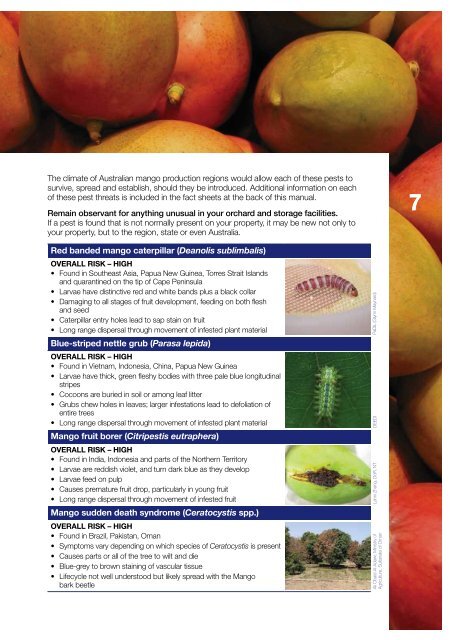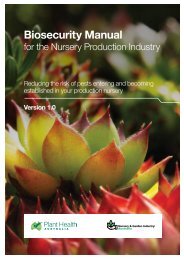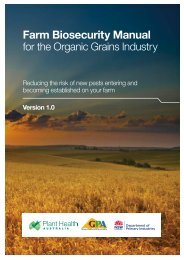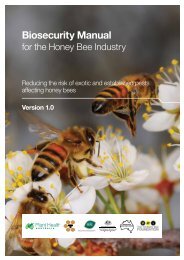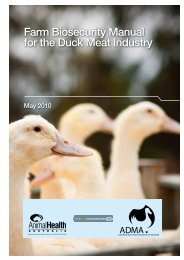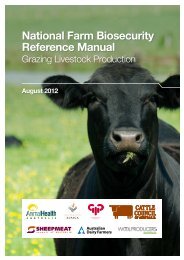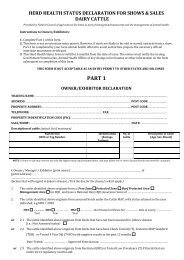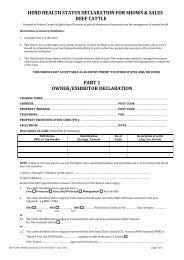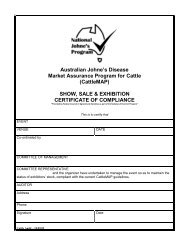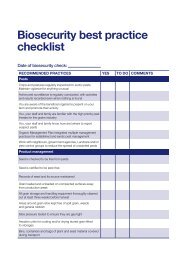Orchard Biosecurity Manual for the Mango Industry - Farm Biosecurity
Orchard Biosecurity Manual for the Mango Industry - Farm Biosecurity
Orchard Biosecurity Manual for the Mango Industry - Farm Biosecurity
You also want an ePaper? Increase the reach of your titles
YUMPU automatically turns print PDFs into web optimized ePapers that Google loves.
The climate of Australian mango production regions would allow each of <strong>the</strong>se pests to<br />
survive, spread and establish, should <strong>the</strong>y be introduced. Additional in<strong>for</strong>mation on each<br />
of <strong>the</strong>se pest threats is included in <strong>the</strong> fact sheets at <strong>the</strong> back of this manual.<br />
Remain observant <strong>for</strong> anything unusual in your orchard and storage facilities.<br />
If a pest is found that is not normally present on your property, it may be new not only to<br />
your property, but to <strong>the</strong> region, state or even Australia.<br />
Red banded mango caterpillar (Deanolis sublimbalis)<br />
OVERALL RISK – HIGH<br />
• Found in Sou<strong>the</strong>ast Asia, Papua New Guinea, Torres Strait Islands<br />
and quarantined on <strong>the</strong> tip of Cape Peninsula<br />
• Larvae have distinctive red and white bands plus a black collar<br />
• Damaging to all stages of fruit development, feeding on both flesh<br />
and seed<br />
• Caterpillar entry holes lead to sap stain on fruit<br />
• Long range dispersal through movement of infested plant material<br />
Blue-striped nettle grub (Parasa lepida)<br />
OVERALL RISK – HIGH<br />
• Found in Vietnam, Indonesia, China, Papua New Guinea<br />
• Larvae have thick, green fleshy bodies with three pale blue longitudinal<br />
stripes<br />
• Cocoons are buried in soil or among leaf litter<br />
• Grubs chew holes in leaves; larger infestations lead to defoliation of<br />
entire trees<br />
• Long range dispersal through movement of infested plant material<br />
<strong>Mango</strong> fruit borer (Citripestis eutraphera)<br />
OVERALL RISK – HIGH<br />
• Found in India, Indonesia and parts of <strong>the</strong> Nor<strong>the</strong>rn Territory<br />
• Larvae are reddish violet, and turn dark blue as <strong>the</strong>y develop<br />
• Larvae feed on pulp<br />
• Causes premature fruit drop, particularly in young fruit<br />
• Long range dispersal through movement of infested fruit<br />
<strong>Mango</strong> sudden death syndrome (Ceratocystis spp.)<br />
OVERALL RISK – HIGH<br />
• Found in Brazil, Pakistan, Oman<br />
• Symptoms vary depending on which species of Ceratocystis is present<br />
• Causes parts or all of <strong>the</strong> tree to wilt and die<br />
• Blue-grey to brown staining of vascular tissue<br />
• Lifecycle not well understood but likely spread with <strong>the</strong> <strong>Mango</strong><br />
bark beetle<br />
PaDIL (Glynn Maynard)<br />
DEEDI<br />
Lanni Zhang, DoR, NT<br />
Ali Obaid Al-Adawi, Ministry of<br />
Agriculture, Sultanate of Oman<br />
7


